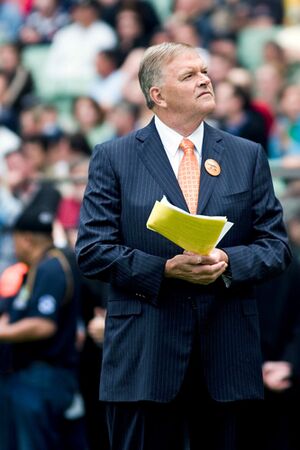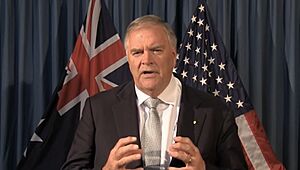Kim Beazley facts for kids
Quick facts for kids
Kim Beazley
|
|||||||||||||||||||||||||||||||||||||||||||||||||||||
|---|---|---|---|---|---|---|---|---|---|---|---|---|---|---|---|---|---|---|---|---|---|---|---|---|---|---|---|---|---|---|---|---|---|---|---|---|---|---|---|---|---|---|---|---|---|---|---|---|---|---|---|---|---|
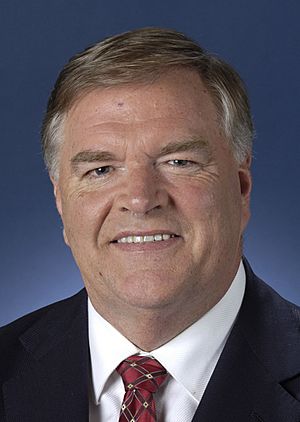
Official portrait, 2010
|
|||||||||||||||||||||||||||||||||||||||||||||||||||||
| Governor of Western Australia | |||||||||||||||||||||||||||||||||||||||||||||||||||||
| In office 1 May 2018 – 30 June 2022 |
|||||||||||||||||||||||||||||||||||||||||||||||||||||
| Monarch | Elizabeth II | ||||||||||||||||||||||||||||||||||||||||||||||||||||
| Premier | Mark McGowan | ||||||||||||||||||||||||||||||||||||||||||||||||||||
| Preceded by | Kerry Sanderson | ||||||||||||||||||||||||||||||||||||||||||||||||||||
| Succeeded by | Chris Dawson | ||||||||||||||||||||||||||||||||||||||||||||||||||||
| Leader of the Opposition | |||||||||||||||||||||||||||||||||||||||||||||||||||||
| In office 28 January 2005 – 4 December 2006 |
|||||||||||||||||||||||||||||||||||||||||||||||||||||
| Prime Minister | John Howard | ||||||||||||||||||||||||||||||||||||||||||||||||||||
| Deputy | Jenny Macklin | ||||||||||||||||||||||||||||||||||||||||||||||||||||
| Preceded by | Mark Latham | ||||||||||||||||||||||||||||||||||||||||||||||||||||
| Succeeded by | Kevin Rudd | ||||||||||||||||||||||||||||||||||||||||||||||||||||
| In office 19 March 1996 – 22 November 2001 |
|||||||||||||||||||||||||||||||||||||||||||||||||||||
| Prime Minister | John Howard | ||||||||||||||||||||||||||||||||||||||||||||||||||||
| Deputy | |||||||||||||||||||||||||||||||||||||||||||||||||||||
| Preceded by | John Howard | ||||||||||||||||||||||||||||||||||||||||||||||||||||
| Succeeded by | Simon Crean | ||||||||||||||||||||||||||||||||||||||||||||||||||||
| Deputy Prime Minister of Australia | |||||||||||||||||||||||||||||||||||||||||||||||||||||
| In office 20 June 1995 – 11 March 1996 |
|||||||||||||||||||||||||||||||||||||||||||||||||||||
| Prime Minister | Paul Keating | ||||||||||||||||||||||||||||||||||||||||||||||||||||
| Preceded by | Brian Howe | ||||||||||||||||||||||||||||||||||||||||||||||||||||
| Succeeded by | Tim Fischer | ||||||||||||||||||||||||||||||||||||||||||||||||||||
| Leader of the House | |||||||||||||||||||||||||||||||||||||||||||||||||||||
| In office 15 February 1988 – 11 March 1996 |
|||||||||||||||||||||||||||||||||||||||||||||||||||||
| Prime Minister | Bob Hawke Paul Keating |
||||||||||||||||||||||||||||||||||||||||||||||||||||
| Preceded by | Mick Young | ||||||||||||||||||||||||||||||||||||||||||||||||||||
| Succeeded by | Peter Reith | ||||||||||||||||||||||||||||||||||||||||||||||||||||
|
|||||||||||||||||||||||||||||||||||||||||||||||||||||
|
|||||||||||||||||||||||||||||||||||||||||||||||||||||
| Ambassador of Australia to the United States |
|||||||||||||||||||||||||||||||||||||||||||||||||||||
| In office 17 February 2010 – 22 January 2016 |
|||||||||||||||||||||||||||||||||||||||||||||||||||||
| Prime Minister | |||||||||||||||||||||||||||||||||||||||||||||||||||||
| Preceded by | Dennis Richardson | ||||||||||||||||||||||||||||||||||||||||||||||||||||
| Succeeded by | Joe Hockey | ||||||||||||||||||||||||||||||||||||||||||||||||||||
| Member of the Australian Parliament for Brand |
|||||||||||||||||||||||||||||||||||||||||||||||||||||
| In office 2 March 1996 – 17 October 2007 |
|||||||||||||||||||||||||||||||||||||||||||||||||||||
| Preceded by | Wendy Fatin | ||||||||||||||||||||||||||||||||||||||||||||||||||||
| Succeeded by | Gary Gray | ||||||||||||||||||||||||||||||||||||||||||||||||||||
| Member of the Australian Parliament for Swan |
|||||||||||||||||||||||||||||||||||||||||||||||||||||
| In office 18 October 1980 – 2 March 1996 |
|||||||||||||||||||||||||||||||||||||||||||||||||||||
| Preceded by | John Martyr | ||||||||||||||||||||||||||||||||||||||||||||||||||||
| Succeeded by | Don Randall | ||||||||||||||||||||||||||||||||||||||||||||||||||||
| Personal details | |||||||||||||||||||||||||||||||||||||||||||||||||||||
| Born |
Kim Christian Beazley
14 December 1948 Subiaco, Western Australia, Australia |
||||||||||||||||||||||||||||||||||||||||||||||||||||
| Political party | Labor | ||||||||||||||||||||||||||||||||||||||||||||||||||||
| Spouses |
|
||||||||||||||||||||||||||||||||||||||||||||||||||||
| Children | 3, including Hannah | ||||||||||||||||||||||||||||||||||||||||||||||||||||
| Parents |
|
||||||||||||||||||||||||||||||||||||||||||||||||||||
| Education | Hollywood Senior High School | ||||||||||||||||||||||||||||||||||||||||||||||||||||
| Alma mater | |||||||||||||||||||||||||||||||||||||||||||||||||||||
| Profession | Academic, politician, diplomat | ||||||||||||||||||||||||||||||||||||||||||||||||||||
Kim Christian Beazley (born 14 December 1948) is an Australian who has held many important roles. He was a politician, a diplomat, and even the Governor of Western Australia. Since 2022, he has been the chairman of the Australian War Memorial.
Before that, he led the Australian Labor Party (ALP) and was the Leader of the Opposition twice. He served in the government as a cabinet minister under Prime Ministers Bob Hawke and Paul Keating. After leaving parliament, he was Australia's Ambassador to the United States from 2010 to 2016. He then became the 33rd governor of Western Australia from 2018 to 2022.
Contents
Early Life and Education
Kim Beazley was born in Subiaco, Western Australia, on 14 December 1948. His father, Kim Beazley Sr., was also a politician. He was a Labor Member of Parliament (MP) for Fremantle from 1945 to 1977. His mother, Betty Judge, was a champion athlete in Australia.
Kim Beazley had polio when he was six years old. He went to Hollywood Senior High School. Later, he studied at the University of Western Australia, where he earned two degrees. He then won a special scholarship called a Rhodes Scholarship to study at Balliol College, Oxford in England. While at Oxford, he became friends with Tony Blair, who later became the Prime Minister of the United Kingdom.
After returning to Australia, Beazley taught politics at Murdoch University in Perth. He had been a member of the Labor Party since he was young. In 1979, he was chosen to run for the seat of Division of Swan. He was elected to the House of Representatives in the 1980 election.
Political Career
Serving as a Cabinet Minister (1983–1996)
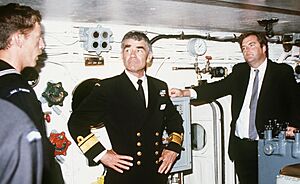
When Bob Hawke became Prime Minister in 1983, he immediately appointed Kim Beazley to his cabinet. A cabinet is a group of senior ministers who make important decisions for the government. Beazley's first role was Minister for Aviation. This meant he was in charge of things related to air travel.
After the 1984 election, Beazley became Minister for Defence. He held this important job until 1990, making him one of the longest-serving Defence Ministers. He was very active in this role and helped set up the Royal Australian Navy's submarine program. Because of his strong interest in military matters, the press sometimes called him "Bomber Beazley."
In 1988, Prime Minister Hawke also made Beazley the Leader of the House. This role involves managing the government's business in parliament. He kept this job until the Labor government finished in 1996.
After the 1990 election, Beazley asked to become Minister for Transport and Communications. This allowed him to focus more on issues within Australia. He supported Prime Minister Hawke during a challenging time when Paul Keating was trying to become leader. When Keating did become Prime Minister in December 1991, he made Beazley the Minister for Employment and Education. In this role, Beazley helped create programs to help people move from welfare to work.
In 1993, after Labor won another election, Keating appointed Beazley as Minister for Finance. Here, he helped create a system for compulsory superannuation schemes. This helps Australians save for their retirement. In 1995, Beazley was chosen to be the Deputy Leader of the Labor Party. He then became the Deputy Prime Minister, a role he held until Labor lost the 1996 election.
Over the years, it became harder for Beazley to keep his seat in parliament. So, before the 1996 election, he moved to a safer Labor seat called Brand.
Leading the Opposition (1996–2001)
After Labor lost the 1996 election to the Coalition led by John Howard, Kim Beazley was chosen to be the Leader of the Labor Party. This also made him the Leader of the Opposition.
Beazley started strongly in this new role. He became popular in opinion polls, especially after John Howard introduced a Goods and Services Tax (GST), which he had promised not to do. In the 1998 election, Labor won more votes overall. However, they did not win enough seats to form the government.
Even though they lost, Beazley was re-elected as Labor Leader without anyone opposing him. For the next three years, Labor was ahead in the opinion polls. It seemed they would win the next election. But in August 2001, after an event involving asylum seekers, Beazley's popularity dropped. The September 11 attacks also led to more support for Prime Minister Howard. As a result, Labor lost the 2001 election.
Backbencher and Shadow Minister (2001–2005)
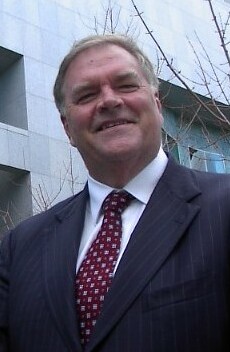
After losing two elections, Beazley decided to step down as Labor Leader in 2001. Simon Crean took over. Beazley then sat on the backbench, meaning he was a regular Member of Parliament without a leadership role.
In 2003, Beazley tried to become leader again but was not successful. However, in July 2004, the new Labor leader, Mark Latham, asked Beazley to return to the frontbench. He became the Shadow Defence Minister. This move was seen as a way to show Australians that a Labor government would still have a strong relationship with the United States.
Second Time as Leader of the Opposition (2005–2006)
After Labor lost the 2004 election, Mark Latham resigned. Kim Beazley was then chosen again as Labor Leader in January 2005. He said he was confident he could lead Labor to win the next election.
In 2006, Beazley focused Labor's efforts on a scandal involving the Australian Wheat Board and the government's new WorkChoices laws. However, his leadership faced challenges, and his popularity in opinion polls was low.
On 30 November 2006, Kevin Rudd announced he would challenge Beazley for the leadership. On 4 December, Rudd won the vote, and Beazley was no longer the leader. Beazley later announced he would retire from Parliament. It was also revealed that his brother had passed away on the same day as the leadership vote. Many people, including Prime Minister John Howard, praised Beazley as a "thoroughly decent man."
Some people later said that removing Beazley as leader might have been a mistake. This was because the Labor Party faced many leadership changes in the years that followed.
After Politics
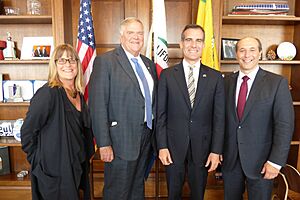
Kim Beazley retired from Parliament at the 2007 election, which Labor won. In 2009, he received a high honour, becoming a Companion of the Order of Australia (AC), for his service to the Australian Parliament.
He became a professor at the University of Western Australia, teaching politics and international relations. He also served as the Chancellor of the Australian National University for a year.
Ambassador to the United States (2010–2016)
In September 2009, Prime Minister Kevin Rudd announced that Kim Beazley would become Australia's Ambassador to the United States. He started this important role on 17 February 2010. As Ambassador, he worked to promote free trade between countries. He finished his term in January 2016.
Governor of Western Australia (2018–2022)
In 2017, it was suggested that Kim Beazley would become the next governor of Western Australia. On 3 April 2018, the Premier of Western Australia, Mark McGowan, confirmed that Queen Elizabeth II had approved Beazley for the role. Beazley was sworn in as governor on 1 May 2018. The Governor is the Queen's representative in the state.
In an interview, Beazley explained why he continued to serve the public. He said he always cared about Australia's survival and defence. He believed that Australian society was worth protecting and improving for future generations.
| Viceregal styles of Kim Beazley (2018–2022) |
|
|---|---|
 |
|
| Reference style | His Excellency the Honourable |
| Spoken style | Your Excellency |
Chairman of the Australian War Memorial Council
On 2 December 2022, Kim Beazley was appointed chairman of the Australian War Memorial Council. In this role, he continues to speak about Australia's defence. He strongly supports the AUKUS security partnership, which involves nuclear-powered submarines. He believes these submarines will be worth the wait for Australia's safety. He has also said that Australia needs to spend more money on its defence.
Honours and Awards
- 2007: Professorial Fellow of the University of Western Australia
- 2009: Companion of the Order of Australia (AC) for his service to the Australian Parliament.
- 2018: Honorary Commodore in the Royal Australian Navy.
- 2018: Colonel of the Royal Western Australia Regiment.
- 2018: Deputy Prior of the Order of St John.
- 2019: Knight of Grace of the Order of St John.
Personal Life
Kim Beazley has three daughters. He was married to Mary Ciccarelli from 1974 to 1988, and they had two daughters, Jessica and Hannah. He married Susie Annus in 1990, and they have a daughter named Rachel. His daughter Hannah Beazley also became a politician in 2019. She ran for her father's old seat in the 2019 federal election. Later, she won a seat in the Western Australian Legislative Assembly in 2021.
See also
 In Spanish: Kim Beazley para niños
In Spanish: Kim Beazley para niños
- Political families of Australia



